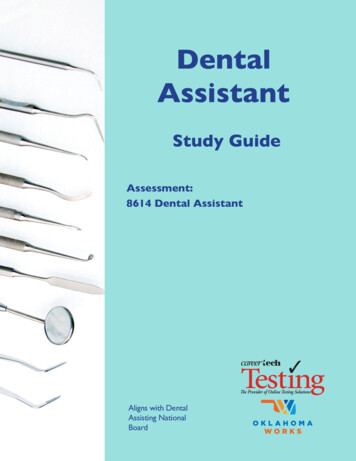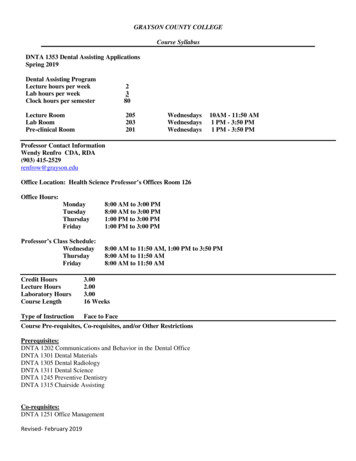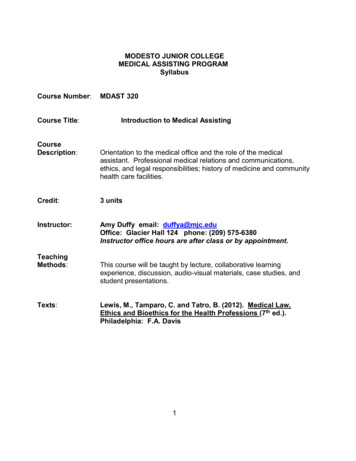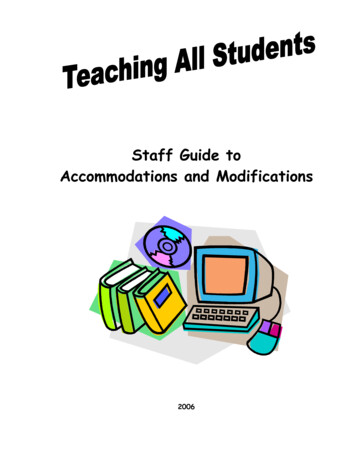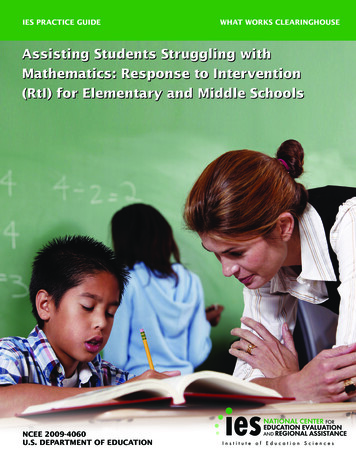
Transcription
IES PRACTICE GUIDEWHAT WORKS CLEARINGHOUSEAssisting Students Struggling withMathematics: Response to Intervention(RtI) for Elementary and Middle SchoolsNCEE 2009-4060U.S. DEPARTMENT OF EDUCATION
The Institute of Education Sciences (IES) publishes practice guides in educationto bring the best available evidence and expertise to bear on the types of systemicchallenges that cannot currently be addressed by single interventions or programs.Authors of practice guides seldom conduct the types of systematic literature searchesthat are the backbone of a meta-analysis, although they take advantage of such workwhen it is already published. Instead, authors use their expertise to identify themost important research with respect to their recommendations, augmented by asearch of recent publications to ensure that research citations are up-to-date.Unique to IES-sponsored practice guides is that they are subjected to rigorous external peer review through the same office that is responsible for independent reviewof other IES publications. A critical task for peer reviewers of a practice guide is todetermine whether the evidence cited in support of particular recommendations isup-to-date and that studies of similar or better quality that point in a different direction have not been ignored. Because practice guides depend on the expertise oftheir authors and their group decisionmaking, the content of a practice guide is notand should not be viewed as a set of recommendations that in every case dependson and flows inevitably from scientific research.The goal of this practice guide is to formulate specific and coherent evidence-basedrecommendations for use by educators addressing the challenge of reducing thenumber of children who struggle with mathematics by using “response to intervention” (RtI) as a means of both identifying students who need more help and providing these students with high-quality interventions. The guide provides practical,clear information on critical topics related to RtI and is based on the best availableevidence as judged by the panel. Recommendations in this guide should not beconstrued to imply that no further research is warranted on the effectiveness ofparticular strategies used in RtI for students struggling with mathematics.
IES PRACTICE GUIDEAssisting Students Strugglingwith Mathematics: Response toIntervention (RtI) for Elementaryand Middle SchoolsApril 2009PanelRussell Gersten (Chair)Instructional Research GroupSybilla BeckmannUniversity of GeorgiaBenjamin ClarkeInstructional Research GroupAnne FoegenIowa State UniversityLaurel MarshHoward County Public School SystemJon R. StarHarvard UniversityBradley WitzelWinthrop UniversityStaffJoseph DiminoMadhavi JayanthiRebecca Newman-GoncharInstructional Research GroupShannon MonahanLibby ScottMathematica Policy ResearchNCEE 2009-4060U.S. DEPARTMENT OF EDUCATION
This report was prepared for the National Center for Education Evaluation and Re gionalAssistance, Institute of Education Sciences under Contract ED-07-CO-0062 by the WhatWorks Clearinghouse, which is operated by Mathematica Policy Research, Inc.DisclaimerThe opinions and positions expressed in this practice guide are the authors’ and donot necessarily represent the opinions and positions of the Institute of Education Sciences or the U.S. Department of Education. This practice guide should be reviewedand applied according to the specific needs of the educators and edu cation agencyusing it, and with full realization that it represents the judgments of the reviewpanel regarding what constitutes sensible practice, based on the research availableat the time of pub lication. This practice guide should be used as a tool to assist indecisionmaking rather than as a “cookbook.” Any references within the documentto specific educational products are illustrative and do not imply endorsement ofthese products to the exclusion of other products that are not referenced.U.S. Department of EducationArne DuncanSecretaryInstitute of Education SciencesSue BetkaActing DirectorNational Center for Education Evaluation and Regional AssistancePhoebe CottinghamCommissionerApril 2009This report is in the public domain. Although permission to reprint this publicationis not necessary, the citation should be:Gersten, R., Beckmann, S., Clarke, B., Foegen, A., Marsh, L., Star, J. R., & Witzel,B. (2009). Assisting students struggling with mathematics: Response to Intervention (RtI) for elementary and middle schools (NCEE 2009-4060). Washington, DC:National Center for Education Evaluation and Regional Assistance, Institute ofEducation Sci ences, U.S. Department of Education. Retrieved from ides/.This report is available on the IES website at http://ies.ed.gov/ncee and ides/.Alternative formatsOn request, this publication can be made available in alternative formats, such asBraille, large print, audiotape, or computer diskette. For more information, call theAlternative Format Center at 202–205–8113.
Assisting Students Struggling with Mathematics:Response to Intervention (RtI) forElementary and Middle SchoolsContentsIntroduction 1The What Works Clearinghouse standards and their relevance to this guide 3Overview 4Summary of the Recommendations 5Scope of the practice guide 9Checklist for carrying out the recommendations 11Recommendation 1. Screen all students to identify those at riskfor potential mathematics difficulties and provide interventionsto students identified as at risk. 13Recommendation 2. Instructional materials for students receivinginterventions should focus intensely on in-depth treatment of wholenumbers in kindergarten through grade 5 and on rational numbers ingrades 4 through 8. These materials should be selected by committee. 18Recommendation 3. Instruction during the intervention should be explicitand systematic. This includes providing models of proficient problem solving,verbalization of thought processes, guided practice, corrective feedback,and frequent cumulative review. 21Recommendation 4. Interventions should include instruction on solvingword problems that is based on common underlying structures. 26Recommendation 5. Intervention materials should include opportunitiesfor students to work with visual representations of mathematical ideas andinterventionists should be proficient in the use of visual representations ofmathematical ideas. 30Recommendation 6. Interventions at all grade levels should devote about10 minutes in each session to building fluent retrieval of basic arithmetic facts. 37Recommendation 7. Monitor the progress of students receiving supplementalinstruction and other students who are at risk. 41Recommendation 8. Include motivational strategies in tier 2 and tier 3interventions. 44Glossary of terms as used in this report 48Appendix A. Postscript from the Institute of Education Sciences 52Appendix B. About the authors 55Appendix C. Disclosure of potential conflicts of interest 59Appendix D. Technical information on the studies 61References 91( iii )
ASSISTING STUDENTS STRUGGLING WITH MATHEMATICS: RESPONSE TO INTERVENTION (RTI)FOR ELEMENTARY AND MIDDLE SCHOOLSList of tablesTable 1.Institute of Education Sciences levels of evidence for practice guides Table 2. Recommendations and corresponding levels of evidence 26Table 3. Sensitivity and specificity 16Table D1. Studies of interventions that included explicit instructionand met WWC Standards (with and without reservations) 69Table D2. Studies of interventions that taught students to discriminateproblem types that met WWC standards (with or without reservations) 73Table D3. Studies of interventions that used visual representationsthat met WWC standards (with and without reservations) Table D4. Studies of interventions that included fact fluency practicesthat met WWC standards (with and without reservations) 77–7883List of examplesExample 1. Change problems 27Example 2. Compare problems 28Example 3. Solving different problems with the same strategy 29Example 4. Representation of the counting on strategy using a number line 33Example 5. Using visual representations for multidigit addition 34Example 6. Strip diagrams can help students make sense of fractions 34Example 7. Manipulatives can help students understand that four multipliedby six means four groups of six, which means 24 total objects 35Example 8. A set of matched concrete, visual, and abstract representationsto teach solving single-variable equations 35Example 9: Commutative property of multiplication 48Example 10: Make-a-10 strategy 49Example 11: Distributive property 50Example 12: Number decomposition 51( iv )
IntroductionStudents struggling with mathematics maybenefit from early interventions aimed atimproving their mathematics ability andultimately preventing subsequent failure.This guide provides eight specific recommendations intended to help teachers,principals, and school administrators useResponse to Intervention (RtI) to identifystudents who need assistance in mathematics and to address the needs of thesestudents through focused interventions.The guide provides suggestions on howto carry out each recommendation andexplains how educators can overcomepotential roadblocks to implementing therecommendations.The recommendations were developed bya panel of researchers and practitionerswith expertise in various dimensions ofthis topic. The panel includes a researchmathematician active in issues relatedto K–8 mathematics education, two professors of mathematics education, several special educators, and a mathematicscoach currently providing professional development in mathematics in schools. Thepanel members worked collaboratively todevelop recommendations based on thebest available research evidence and ourexpertise in mathematics, special education, research, and practice.The body of evidence we considered in developing these recommendations includedevaluations of mathematics interventionsfor low-performing students and studentswith learning disabilities. The panel considered high-quality experimental andquasi-experimental studies, such as thosemeeting the criteria of the What WorksClearinghouse (http://www.whatworks.ed.gov), to provide the strongest evidenceof effectiveness. We also examined studies of the technical adequacy of batte riesof screening and progress monitoringmeasures for recommendations relatingto assessment.In some cases, recommendations reflectevidence-based practices that have beendemonstrated as effective through rigorous research. In other cases, when suchevidence is not available, the recommendations reflect what this panel believes arebest practices. Throughout the guide, weclearly indicate the quality of the evidencethat supports each recommendation.Each recommendation receives a ratingbased on the strength of the research evidence that has shown the effectiveness of arecommendation (table 1). These ratings—strong, moderate, or low—have been defined as follows:Strong refers to consistent and generalizable evidence that an intervention program causes better outcomes.1Moderate refers either to evidence fromstudies that allow strong causal conclusions but cannot be generalized with assurance to the population on which arecommendation is focused (perhaps because the findings have not been widelyreplicated)—or to evidence from studies that are generalizable but have morecausal ambiguity than offered by experimental designs (such as statistical modelsof correlational data or group comparisondesigns for which the equivalence of thegroups at pretest is uncertain).Low refers to expert opinion based on reasonable extrapolations from research andtheory on other topics and evidence fromstudies that do not meet the standards formoderate or strong evidence.1. Following WWC guidelines, we consider a positive, statistically significant effect or large effectsize (i.e., greater than 0.25) as an indicator ofpositive effects.(1)
IntroductionTable 1. Institute of Education Sciences levels of evidence for practice guidesStrongIn general, characterization of the evidence for a recommendation as strong requires bothstudies with high internal validity (i.e., studies whose designs can support causal conclusions)and studies with high external validity (i.e., studies that in total include enough of the rangeof participants and settings on which the recommendation is focused to support the conclusion that the results can be generalized to those participants and settings). Strong evidencefor this practice guide is operationalized as: A systematic review of research that generally meets the standards of the What WorksClearinghouse (WWC) (see http://ies.ed.gov/ncee/wwc/) and supports the effectiveness ofa program, practice, or approach with no contradictory evidence of similar quality; OR Several well-designed, randomized controlled trials or well-designed quasi-experimentsthat generally meet the standards of WWC and support the effectiveness of a program,practice, or approach, with no contradictory evidence of similar quality; OR One large, well-designed, randomized controlled, multisite trial that meets WWC standardsand supports the effectiveness of a program, practice, or approach, with no contradictoryevidence of similar quality; OR For assessments, evidence of reliability and validity that meets the Standards for Educa-tional and Psychological Testing.aIn general, characterization of the evidence for a recommendation as moderate requires studies with high internal validity but moderate external validity, or studies with high externalvalidity but moderate internal validity. In other words, moderate evidence is derived fromstudies that support strong causal conclusions but when generalization is uncertain, or studies that support the generality of a relationship but when the causality is uncertain. Moderateevidence for this practice guide is operationalized as: Moderate LowExperiments or quasi-experiments generally meeting the standards of WWC and supporting the effectiveness of a program, practice, or approach with small sample sizesand/or other conditions of implementation or analysis that limit generalizability andno contrary evidence; ORComparison group studies that do not demonstrate equivalence of groups at pretest and therefore do not meet the standards of WWC but that (a) consistently showenhanced outcomes for participants experiencing a particular program, practice, orapproach and (b) have no major flaws related to internal validity other than lack ofdemonstrated equivalence at pretest (e.g., only one teacher or one class per condition,unequal amounts of instructional time, highly biased outcome measures); ORCorrelational research with strong statistical controls for selection bias and for discerning influence of endogenous factors and no contrary evidence; ORFor assessments, evidence of reliability that meets the Standards for Educational andPsychological Testingb but with evidence of validity from samples not adequately representative of the population on which the recommendation is focused.In general, characterization of the evidence for a recommendation as low means that therecommendation is based on expert opinion derived from strong findings or theories inrelated areas and/or expert opinion buttressed by direct evidence that does not rise tothe moderate or strong levels. Low evidence is operationalized as evidence not meetingthe standards for the moderate or high levels.a. American Educational Research Association, American Psychological Association, and National Council onMeasurement in Education (1999). b. Ibid.(2)
IntroductionThe What Works Clearinghousestandards and their relevance tothis guideThe panel relied on WWC evidence standards to assess the quality of evidencesupporting mathematics intervention programs and practices. The WWC addressesevidence for the causal validity of instructional programs and practices according toWWC standards. Information about thesestandards is available at http://ies.ed.gov/ncee/wwc/references/standards/. Thetechnical quality of each study is rated andplaced into one of three categories: Meets Evidence Standards—for randomized controlled trials and regressiondiscontinuity studies that provide thestrongest evidence of causal validity. Meets Evidence Standards with Reservations—for all quasi-experimentalstudies with no design flaws and randomized controlled trials that haveproblems with randomization, attrition, or disruption. Does Not Meet Evidence Screens—forstudies that do not provide strong evidence of causal validity.Following the recommendations and suggestions for carrying out the recommendations, Appendix D presents informationon the research evidence to support therecommendations.The panel would like to thank Kelly Haymond for her contributions to the analysis,the WWC reviewers for their contributionto the project, and Jo Ellen Kerr and JamilaHenderson for their support of the intricatelogistics of the project. We also would liketo thank Scott Cody for his oversight of theoverall progress of the practice guide.Dr. Russell GerstenDr. Sybilla BeckmannDr. Benjamin ClarkeDr. Anne FoegenMs. Laurel MarshDr. Jon R. StarDr. Bradley Witzel(3)
Assisting StudentsStruggling withMathematics: Responseto Intervention (RtI)for Elementary andMiddle Schoolsconcluded that all students should receivepreparation from an early age to ensuretheir later success in algebra. In particular,the report emphasized the need for mathematics interventions that mitigate andprevent mathematics difficulties.OverviewResponse to Intervention (RtI) is an early detection, prevention, and support system thatidentifies struggling students and assiststhem before they fall behind. In the 2004reauthorization of the Individuals with Disabilities Education Act (PL 108-446), stateswere encouraged to use RtI to accuratelyidentify students with learning disabilitiesand encouraged to provide additional supports for students with academic difficulties regardless of disability classification.Although many states have already begun toimplement RtI in the area of reading, RtI initiatives for mathematics are relatively new.Students’ low achievement in mathematics is a matter of national concern. The recent National Mathematics Advisory PanelReport released in 2008 summarized thepoor showing of students in the UnitedStates on international comparisons ofmathematics performance such as theTrends in International Mathematics andScience Study (TIMSS) and the Program forInternational Student Assessment (PISA).2A recent survey of algebra teachers associated with the report identified keydeficiencies of students entering algebra,including aspects of whole number arithmetic, fractions, ratios, and proportions.3The National Mathematics Advisory Panel2. See, for example, National Mathematics Advisory Panel (2008) and Schmidt and Houang(2007). For more information on the TIMSS, seehttp://nces.ed.gov/timss/. For more informationon PISA, see http://www.oecd.org.3. National Mathematics Advisory Panel (2008).This panel believes that schools can use anRtI framework to help struggling studentsprepare for later success in mathematics. To date, little research has been conducted to identify the most effective waysto initiate and implement RtI frameworksfor mathematics. However, there is a richbody of research on effective mathematicsinterventions implemented outside an RtIframework. Our goal in this practice guideis to provide suggestions for assessingstudents’ mathematics abilities and implementing mathematics interventions withinan RtI framework, in a way that reflectsthe best evidence on effective practices inmathematics interventions.RtI begins with high-quality instructionand universal screening for all students.Whereas high-quality instruction seeks toprevent mathematics difficulties, screening allows for early detection of difficulties if they emerge. Intensive interventionsare then provided to support studentsin need of assistance with mathematicslearning.4 Student responses to intervention are measured to determine whetherthey have made adequate progress and (1)no longer need intervention, (2) continueto need some intervention, or (3) needmore intensive intervention. The levels ofintervention are conventionally referredto as “tiers.” RtI is typically thought of ashaving three tiers.5 Within a three-tieredRtI model, each tier is defined by specificcharacteristics.4. Fuchs, Fuchs, Craddock et al. (2008).5. Fuchs, Fuchs, and Vaughn (2008) make thecase for a three-tier RtI model. Note, however,that some states and school districts have implemented multitier intervention systems with morethan three tiers.(4)
Overview Tier 1 is the mathematics instructionthat all students in a classroom receive.It entails universal screening of all students, regardless of mathematics proficiency, using valid measures to identifystudents at risk for future academicfailure—so that they can receive earlyintervention.6 There is no clear consensus on the characteristics of instructionother than that it is “high quality.”7 In tier 2 interventions, schools provideadditional assistance to students whodemonstrate difficulties on screeningmeasures or who demonstrate weakprogress.8 Tier 2 students receive supplemental small group mathematicsinstruction aimed at building targetedmathematics proficiencies.9 These interventions are typically provided for20 to 40 minutes, four to five times eachweek.10 Student progress is monitoredthroughout the intervention.11student performance data is critical inthis tier. Typically, specialized personnel, such as special education teachersand school psychologists, are involvedin tier 3 and special education services.14However, students often receive relevant mathematics interventions from awide array of school personnel, including their classroom teacher.Summary of the Recommendations Tier 3 interventions are provided tostudents who are not benefiting fromtier 2 and require more intensive assistance.12 Tier 3 usually entails oneon-one tutoring along with an appropriate mix of instructional interventions.In some cases, special education services are included in tier 3, and in others special education is considered anadditional tier.13 Ongoing analysis of6. For reviews see Jiban and Deno (2007); Fuchs,Fuchs, Compton et al. (2007); Gersten, Jordan,and Flojo (2005).7. National Mathematics Advisory Panel (2008);National Research Council (2001).8. Fuchs, Fuchs, Craddock et al. (2008); National Joint Committee on Learning Disabilities(2005).9. Fuchs, Fuchs, Craddock et al. (2008).10. For example, see Jitendra et al. (1998) andFuchs, Fuchs, Craddock et al. (2008).11. National Joint Committee on Learning Disabilities (2005).This practice guide offers eight recommendations for identifying and supportingstudents struggling in mathematics (table2). The recommendations are intended tobe implemented within an RtI framework(typically three-tiered). The panel chose tolimit its discussion of tier 1 to universalscreening practices (i.e., the guide doesnot make recommendations for generalclassroom mathematics instruction). Recommendation 1 provides specific suggestions for conducting universal screeningeffectively. For RtI tiers 2 and 3, recommendations 2 though 8 focus on the mosteffective content and pedagogical practices that can be included in mathematicsinterventions.Throughout this guide, we use the term“interventionist” to refer to those teaching the intervention. At a given school, theinterventionist may be the general classroom teacher, a mathematics coach, a special education instructor, other certifiedschool personnel, or an instructional assistant. The panel recognizes that schoolsrely on different personnel to fill theseroles depending on state policy, schoolresources, and preferences.Recommendation 1 addresses the type ofscreening measures that should be used intier 1. We note that there is more researchon valid screening measures for students in12. Fuchs, Fuchs, Craddock et al. (2008).13. Fuchs, Fuchs, Craddock et al. (2008); NationalJoint Committee on Learning Disabilities (2005).14. National Joint Committee on Learning Disabilities (2005).(5)
OverviewTable 2. Recommendations and corresponding levels of evidenceRecommendationLevel of evidenceTier 11. Screen all students to identify those at risk for potential mathematicsdifficulties and provide interventions to students identified as at risk.ModerateTiers 2 and 32. Instructional materials for students receiving interventions shouldfocus intensely on in-depth treatment of whole numbers in kindergarten through grade 5 and on rational numbers in grades 4 through 8.These materials should be selected by committee.Low3. Instruction during the intervention should be explicit and systematic.This includes providing models of proficient problem solving, verbalization of thought processes, guided practice, corrective feedback, andfrequent cumulative review.Strong4. Interventions should include instruction on solving word problemsthat is based on common underlying structures.Strong5. Intervention materials should include opportunities for students towork with visual representations of mathematical ideas and interventionists should be proficient in the use of visual representations ofmathematical ideas.Moderate6. Interventions at all grade levels should devote about 10 minutes in eachsession to building fluent retrieval of basic arithmetic facts.Moderate7. Monitor the progress of students receiving supplemental instructionand other students who are at risk.Low8. Include motivational strategies in tier 2 and tier 3 interventions.LowSource: Authors’ compilation based on analysis described in text.(6)
Overviewkindergarten through grade 2,15 but thereare also reasonable strategies to use for students in more advanced grades.16 We stressthat no one screening measure is perfectand that schools need to monitor the progress of students who score slightly above orslightly below any screening cutoff score.Recommendations 2 though 6 address thecontent of tier 2 and tier 3 interventionsand the types of instructional strategiesthat should be used. In recommendation 2,we translate the guidance by the NationalMathematics Advisory Panel (2008) andthe National Council of Teachers of Mathematics Curriculum Focal Points (2006)into suggestions for the content of intervention curricula. We argue that the mathematical focus and the in-depth coverageadvocated for proficient students are alsonecessary for students with mathematicsdifficulties. For most students, the contentof interventions will include foundationalconcepts and skills introduced earlier inthe student’s career but not fully understood and mastered. Whenever possible,links should be made between foundational mathematical concepts in the intervention and grade-level material.At the center of the intervention recommendations is that instruction should besystematic and explicit (recommendation3). This is a recurrent theme in the bodyof valid scientific research.17 We explorethe multiple meanings of explicit instruction and indicate which components ofexplicit instruction appear to be most related to improved student outcomes. Webelieve this information is important fordistricts and state departments to haveas they consider selecting materials and15. Gersten, Jordan, and Flojo (2005); Gersten,Clarke, and Jordan (2007).16. Jiban and Deno (2007); Foegen, Jiban, andDeno (2007).17. Darch, Carnine, and Gersten (1984); Fuchset al. (2003a); Jitendra et al. (1998); Schunk andCox (1986); Tournaki (2003); Wilson and Sindelar(1991).providing professional development forinterventionists.Next, we highlight several areas of research that have produced promising findings in mathematics interventions. Theseinclude systematically teaching studentsabout the problem types associated witha given operation and its inverse (such asproblem types that indicate addition andsubtraction) (recommendation 4).18 We alsorecommend practices to help studentstranslate abstract symbols and numbersinto meaningful visual representations(recommendation 5).19 Another featurethat we identify as crucial for long-termsuccess is systematic instruction to buildquick retrieval of basic arithmetic facts(recommendation 6). Some evidence existssupporting the allocation of time in the intervention to practice fact retrieval usingflash cards or computer software.20 Thereis also evidence that systematic work withproperties of operations and countingstrategies (for younger students) is likelyto promote growth in other areas of mathematics beyond fact retrieval.21The final two recommendations addressother considerations in implementing tier2 and tier 3 interventions. Recommendation 7 addresses the importance of monitoring the progress of students receiving18. Jitendra et al. (1998); Xin, Jitendra, and Deatline-Buchman (2005); Darch, Carnine, and Gersten(1984); Fuchs et al. (2003a); Fuchs et al. (2003b);Fuchs, Fuchs, Prentice et al. (2004); Fuchs, Fuchs,and Finelli (2004); Fuchs, Fuchs, Craddock et al.(2008) Fuchs, Seethaler et al. (2008).19. Artus and Dyrek (1989); Butler et al. (2003);Darch, Carnine, and Gersten (1984); Fuchs etal. (2005); Fuchs, Seethaler et al. (2008); Fuchs,Powell et al. (2008); Fuchs, Fuchs, Craddock etal. (2008); Jitendra et al. (1998); Walker and Poteet (1989); Wilson and Sindelar (1991); Witzel(2005); Witzel, Mercer, and Miller (2003); Woodward (2006).20. Beirne-Smith (1991); Fuchs, Seethaler et al.(2008); Fuchs et al. (2005); Fuchs, Fuchs, Hamlettet al. (2006); Fuchs, Powell et al. (2008).21. Tournaki (2003); Woodward (2006).(7)
Overviewinterventions. Specific types of formativeassessment approaches and measures aredescribed. We argue for two types of ongoing assessment. One is the use of curriculum-embedded assessments that gauge howwell student
Alternative Format Center at 202-205-8113. ( iii ) Assisting Students Struggling with Mathematics: Response to Intervention (RtI) for Elementary and Middle Schools Contents . with learning disabilities. The panel con-sidered high-quality experimental and quasi-experimental studies, such as those
